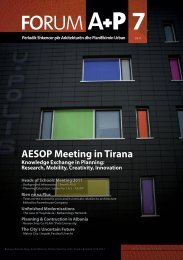Forum A+P 08
POLIS University publishes the “Forum A+P” journal, the only scientific and cultural magazine in the Albanian –speaking countries for the fields of architecture and territory planning. This magazine is recognized by the Ministry of Education and Science, the Academic Degrees Evaluation Committee and has an ISSN international registration code in France. The magazine is published in Albanian and English language and contains a package of scientific, informative articles and analysis.
POLIS University publishes the “Forum A+P” journal, the only scientific and cultural magazine in the Albanian –speaking countries for the fields of architecture and territory planning. This magazine is recognized by the Ministry of Education and Science, the Academic Degrees Evaluation Committee and has an ISSN international registration code in France. The magazine is published in Albanian and English language and contains a package of scientific, informative articles and analysis.
- No tags were found...
You also want an ePaper? Increase the reach of your titles
YUMPU automatically turns print PDFs into web optimized ePapers that Google loves.
uilt and installed the pavilion and a number<br />
of other projects before his premature death<br />
in 1993. The Expo project attracted much<br />
favorable attention, including that of another<br />
young architect named Richard Rogers, who<br />
although born in Florence was English. The<br />
Colin Amery, Architectural Critic says that one<br />
of the most important results of the winning<br />
of the competition was the meeting between<br />
Renzo Piano and the engineer Peter Rice of Ove<br />
Arup and Partners. There was instant rapport<br />
between this brilliantly inventive British<br />
two architects found that they had a great<br />
deal in common and when an engineering<br />
firm suggested that they work together and<br />
enter the international competition for the<br />
Georges Pompidou Center (also known as<br />
Beaubourg) in Paris; they did and won. The<br />
result was a hundred thousand square meters<br />
(over a million square feet) in the heart of<br />
Paris, devoted to the figurative arts, music,<br />
industrial design, and literature. In the two<br />
decades since it opened, over a 150,000,000<br />
people have visited it, averaging more than<br />
25,000 people per day—an overwhelming<br />
success—both with the people of Paris and the<br />
international media. Both Rogers and Piano<br />
became recognizable names throughout the<br />
world.<br />
engineer and the young Italian architect, and<br />
Peter Rice was to be Piano’s engineer until his<br />
premature death in 1992.<br />
There was to be a curious time after the<br />
Pompidou Centre opened in 1977. Piano felt<br />
a sense of exhaustion and fatigue. It had been<br />
an enormous lesson in both architecture<br />
and life and a triumph for teamwork and<br />
constructional innovation. It must have<br />
seemed to the young architect that this would<br />
never be repeated. In some ways he would<br />
have been right. He was never to build with<br />
Richard Rogers again and he was to abandon<br />
the kind of colourful anarchy of the sixties<br />
that infused the Pompidou.<br />
Described often as “high tech,” Piano<br />
prefers other modifiers. In his own words,<br />
207





